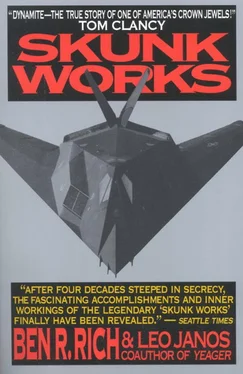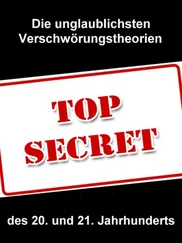Kelly’s motto was “Be quick, be quiet, be on time.” For many of us, he was the only boss we had ever known, and my first day seated behind his huge desk in the big three-hundred-square-foot corner office where Kelly had commanded every aspect of our daily operations, I felt like a three-and-half-foot-tall impostor, even though my kingdom was a windowless two-story headquarters building housing three hundred engineers, supervisors, and administrators, who operated behind thick, eavesdrop-proof walls under guard and severe security restrictions in an atmosphere about as cheery as a bomb shelter. The unmarked building was adjacent to a pair of enormous production hangars, with a combined 300,000 square feet of production and assembly space. During World War II, those hangars were used to build P-38 fighters, and later on, the fleet of Lockheed Constellations that dominated postwar commercial aviation. My challenge was to keep those six football fields’ worth of floor space humming with new airplane production and development. The twin giant hangars were three stories high and dwarfed four or five nearby buildings that housed our machine shops and parts factories. Aside from a guard booth that closely screened and monitored all visitors driving into our area, there were no visible signs of the restricted Skunk Works operation. Only those with a real need to know were directed to the location of our headquarters building, which had been built for Kelly in 1962. As austere as the concrete-and-steel facility was, it seemed like a palace to those fifty of us who, back in the early 1950s, had been crammed into the small drafty offices of the original Skunk Works in Building 82, less than three hundred yards away, which was an old bomber production hangar left over from World War II and still used on some of our most sensitive projects.
I enjoyed the goodwill of my colleagues because most of us had worked together intimately under tremendous pressures for more than a quarter century. Working isolated, under rules of tight security, instilled a camaraderie probably unique in the American workplace. I was Kelly’s right-hand man before succeeding him, and that carried heavy freight with most of my Skunk Works colleagues, who seemed more than willing to give me the benefit of the doubt as their new boss—and keep those second guesses to a minimum for at least the first week or so. But all of us, from department heads to the janitorial brigade, had the jitters that followed the loss of a strong father figure like Clarence “Kelly” Johnson, who had taken care of us over the years and made us among the highest-paid group in aerospace, as well as the most productive and respected. Daddy, come back home!
I began by loosening the leash on all my department heads. I told them what they already knew: I was not a genius like Kelly, who knew by experience and instinct how to solve the most complex technical problems. I said, “I have no intention of trying to make all the decisions around here the way that Kelly always did. From now on, you’ll have to make most of the tough calls on your own. I’ll be decisive in telling you what I want, then I’ll step out of your way and let you do it. I’ll take the crap from the big wheels, but if you screw up I want to hear it first.”
I left unspoken the obvious fact that I could not be taking over at a worse time, in the sour aftermath of the Vietnam War, when defense spending was about as low as military morale, and we were down to fifteen hundred workers from a high of six thousand five years earlier. The Ford administration still had two years to run, and Defense Secretary Donald Rumsfeld was acting like a guy with battery problems on his hearing aid when it came to listening to any pitches for new airplanes. And to add anxiety to a less than promising business climate, Lockheed was then teetering on the edge of corporate and moral bankruptcy in the wake of a bribery scandal, which first surfaced the year before I took over and threatened to bring down nearly half a dozen governments around the world.
Lockheed executives admitted paying millions in bribes over more than a decade to the Dutch (Crown Prince Bernhard, husband of Queen Juliana, in particular), to key Japanese and West German politicians, to Italian officials and generals, and to other highly placed figures from Hong Kong to Saudi Arabia, in order to get them to buy our airplanes. Kelly was so sickened by these revelations that he had almost quit, even though the top Lockheed management implicated in the scandal resigned in disgrace.
Lockheed was convulsed by some of the worst troubles to simultaneously confront an American corporation. We were also nearly bankrupt from an ill-conceived attempt to reenter the commercial airliner sweepstakes in 1969 with our own Tristar L-1011 in competition against the McDonnell Douglas DC-10. They used American engines, while we teamed up with Rolls-Royce, thinking that the Anglo-American partnership gave us an advantage in the European market. We had built a dozen airliners when Rolls-Royce unexpectedly declared bankruptcy, leaving us with twelve hugely expensive, engineless “gliders” that nobody wanted. The British government bailed out Rolls-Royce in 1971, and the following year Congress very reluctantly came to our rescue by voting us $250 million in loan guarantees; but our losses ultimately reached a staggering $2 billion, and in late 1974, Textron Corporation almost acquired all of Lockheed at a “fire sale” price of $85 million. The Skunk Works would have been sold off with the corporation’s other assets and then tossed into limbo as a tax write-off.
I had to get new business fast or face mounting pressure from the corporate bean counters to unload my higher-salaried people. Kelly was known far and wide as “Mr. Lockheed.” No one upstairs had dared to cross him. But I was just plain Ben Rich. I was respected by the corporate types, but I had no political clout whatsoever. They demanded that I be a hell of a lot more “client friendly” than Kelly had been. It was an open secret in the industry that Kelly had often been his own worst enemy in his unbending and stubborn dealings with the blue-suiters. Until they had run afoul of our leader, not too many two- or three-star generals had been told to their faces that they didn’t know shit from Shinola. But smoothing relations with Pentagon brass would only serve to push me away from the dock—I had a long hard row ahead to reach the promised land. If the Skunk Works hoped to survive as a viable entity, we somehow would have to refashion the glory years last enjoyed in the 1960s when we had forty-two separate projects going and helped Lockheed become the aerospace industry leader in defense contracts.
I knew there were several powerful enemies of the Skunk Works on Lockheed’s board who would close us down in a flash. They resented our independence and occasional arrogance, and suspected us of being profligate spenders hiding our excesses behind screens of secrecy imposed by our highly classified work. These suspicions were fueled by the fact that Kelly usually got whatever he wanted from Lockheed’s board—whether it was costly new machinery or raises for his top people. Nevertheless, Kelly actually was as tightfisted as any beady-eyed New England banker and would raise hell the moment we began dropping behind schedule or going over budget.
Knowing that I didn’t have much time to find new business, I flew to Washington, hat in hand, with a fresh shoeshine and a brave smile. My objective was to convince General David Jones, the Air Force chief of staff, of the need to restart the production line of the U-2 spy plane. It was a long-shot attempt, to say the least, because never before in history had the blue-suiters ever reopened a production line for any airplane in the Air Force’s inventory. But this airplane was special. I have no doubt that fifty years from now the U-2 will still be in service to the nation. The aircraft was then more than twenty-five years old and remained the mainstay of our airborne reconnaissance activities. It needed to be updated with a more powerful engine and fitted with advanced avionics to become even more effective flying its tactical missions around the world. That meant adding a capability to perform reconnaissance coverage via optical systems that used radar camera images from half a world away.
Читать дальше












